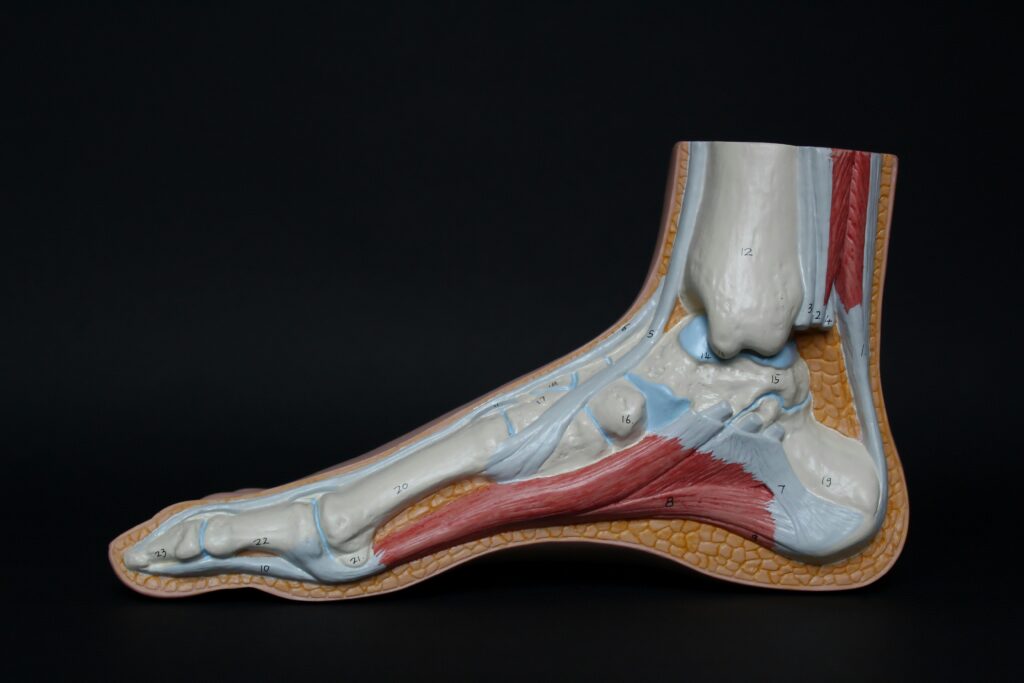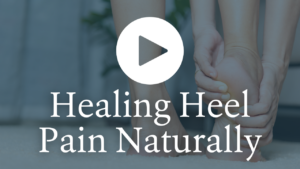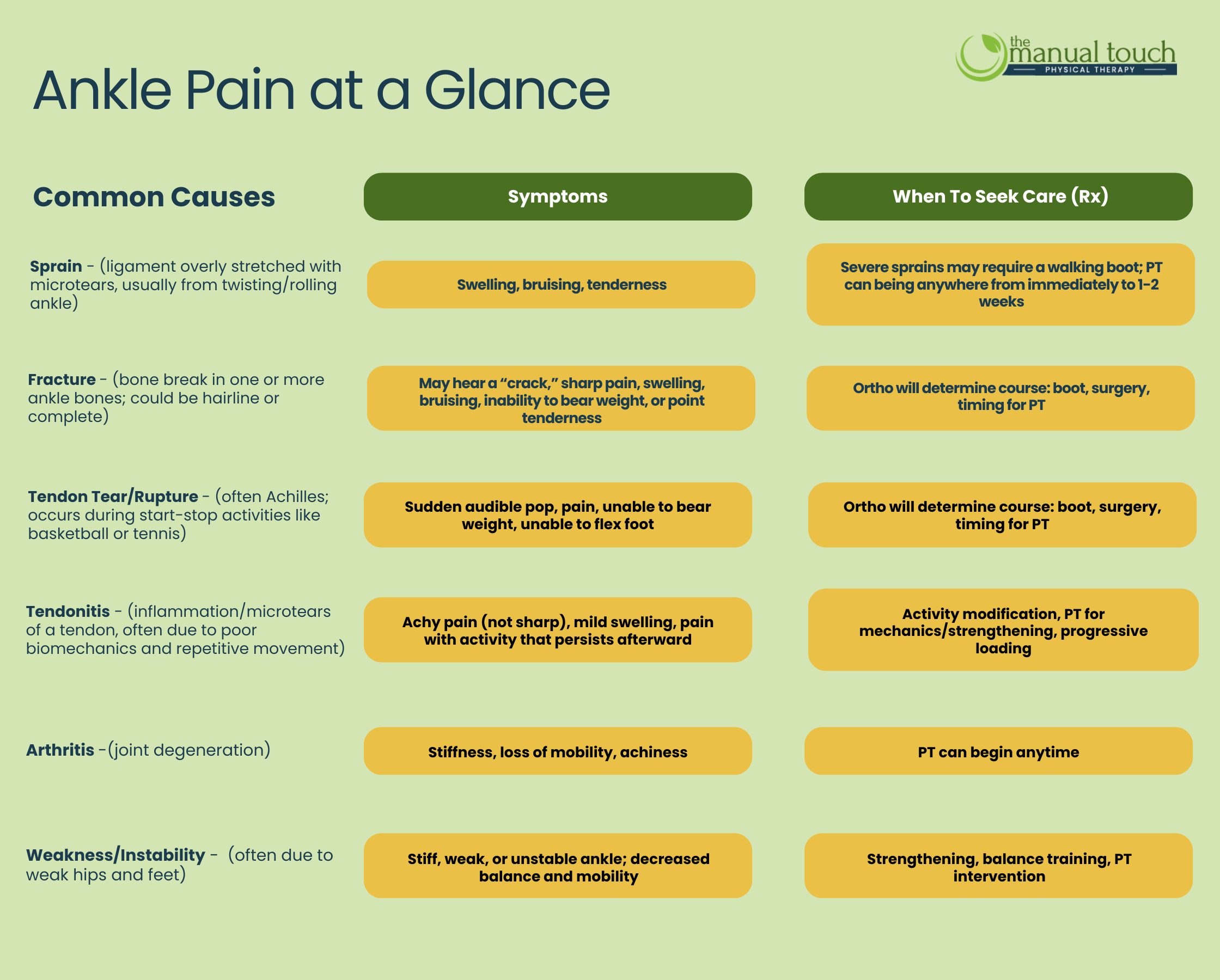Understanding Ankle Pain: Anatomy, Injuries, and What Your Symptoms Are Telling You
Ankle pain can sneak up on you—or knock you off your feet.
Maybe you twisted it stepping off a curb, rolled it during a workout, or it just started aching one day and hasn’t let up.
You ice it, rest it, maybe wear a brace, but weeks go by and it still hurts—or worse, feels weak or unstable.
That’s because while the pain might fade, the strength and stability don’t come back on their own. An ankle injury doesn’t fully heal until you retrain the muscles, tendons, and balance systems through targeted movement and therapy.
If you’ve ever thought, “Why is this still bothering me?” or “It’s been months—shouldn’t it be better by now?”—you’re not alone.
Your Ankles Deserve Attention—Don’t Ignore the Signs
Your ankles carry you through life—literally.
So, ankle pain isn’t something to ignore or “walk off.” Left untreated, it can change your gait, posture, and even affect your knees, hips, or back or even your neck.
But with the right care, most ankle injuries can fully recover—and you don’t have to wait months to start feeling better.
Take Jill, for example. She slipped on a stair and suffered a severe ankle sprain with extensive bruising. She was placed in a walking boot for six weeks, but we began physical therapy just a few days after the injury, with her doctor’s approval, to gently introduce weight-bearing movement outside the boot. This early movement helped improve blood flow, reduce swelling, and jump-start healing.
As her rehab progressed, we added strengthening, balance, and neuromuscular control exercises—because true recovery isn’t just about healing the ankle; it’s about getting the whole body working together again. Jill also received hands-on manual therapy to restore joint mobility in the ankle and address imbalances in other areas that were affecting her gait and movement patterns.
Today, she’s back to walking confidently—and pain-free—because we treated the whole person, not just the injury.
The good news? Most ankle issues can be resolved with the right approach—and the sooner you address them, the better your outcomes will be.
Healing Takes Time… And Patience
About 10 years ago, I completed a half-marathon. Just three days later, I started to notice a dull ache on the outside of my ankle.
An MRI confirmed that I had peroneal tendinopathy. Every activity I tried seemed to aggravate the achiness, both during and afterward. The only things I could tolerate were swimming, aqua jogging, and going to physical therapy.
It was a frustrating setback, but with consistent rehab, it took me about four months to fully recover and get back to running.
That experience taught me how important proper recovery is and how patient you need to be when it comes to ankle injuries.
The Anatomy of Your Ankle – A Foundation Built for Movement
Your ankle is primarily a hinge joint, but as a whole, it is a complex joint that allows for movements in all directions. It’s an integral and complex joint that balances strength, flexibility, and precision every time you take a step.
Here’s what makes it work:
- Bones: The tibia (shin bone), fibula (outer leg bone), and talus (top ankle bone) form the ankle joint. These bones bear weight and transfer force.
- Ligaments: These sturdy bands connect bone to bone, providing crucial stability—especially during dynamic movements like walking, running, or pivoting.
- Tendons & Muscles: These move your ankle and foot. Key players include the Achilles tendon, connects the calf muscle to your heal, and the peroneal tendons, on the outside of the ankle, which control side-to-side motion.
- Alignment & Load Distribution: Your ankle has to absorb impact, adapt to terrain, and support your entire body. Even minor misalignments can ripple upward into knee, hip, and back pain.
Takeaway: The ankle is a finely tuned system. If one part is off, you’ll feel it—and often in more than just your ankle.
What to Do When Ankle Pain Strikes
I always say: the sooner you act, the faster you recover. Here’s what to do:
Seek Medical Attention If:
- You can’t bear weight
- The swelling or bruising is severe
- You heard a pop or crack during the injury
- Pain persists beyond a few days with no improvement
Tips for Immediate Care:
- R.I.C.E. (Rest, Ice, Compression, Elevation)
- Visit a walk-in ortho clinic
- Gentle range of motion if tolerable; depending on diagnoses can be weight bearing; early mobility and balance exercises for ankle sprains will help the healing process
- Avoid “pushing through” the pain—it only delays healing
- Choose supportive shoes, get properly fitted for the correct shoe and avoid going barefoot on hard surfaces
Why Diagnosis Matters
Knowing whether you’ve got a strain, sprain, or break helps your PT (like me!) create the right recovery plan. Guesswork doesn’t work when it comes to healing.
Physical Therapy Can Help You:
Whether you’re dealing with ankle instability, recovering from a sprain, or facing long-term discomfort, physical therapy can make all the difference. With the right plan, we can:
- Reduce pain and swelling naturally
- Restore strength and balance even if the injury happened a long time ago
- Improve foot and ankle mobility particularly as you age your joints and soft tissue become more rigid and stiff putting you at risk for falls
- Prevent future injuries through targeted movement training
- Neuromuscular control – exercises to improve the coordination of movement between your feet and core
- Evaluate your footwear
My Approach at The Manual Touch
I’ve worked with hundreds of people over the years who came in thinking their ankle injury had “mostly healed”—but they were still limping, favoring one side, or avoiding activity altogether. The problem? Their ankle wasn’t fully functional or integrated with the rest of your body yet.
I always begin with a whole-body assessment, not just your ankle. Why? Ankle pain or mobility limitations often stem from or lead to dysfunction elsewhere. We’ll work together on customized exercises, hands-on therapy, and real-life movement corrections that fit your lifestyle and goals.
Takeaway: Whether your pain came on fast or slow, your body is waving a flag—something isn’t functioning right, and it’s time to intervene.











Leave a Reply